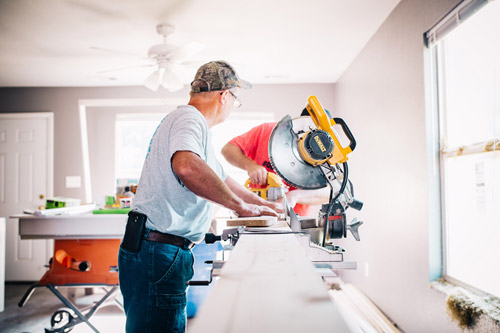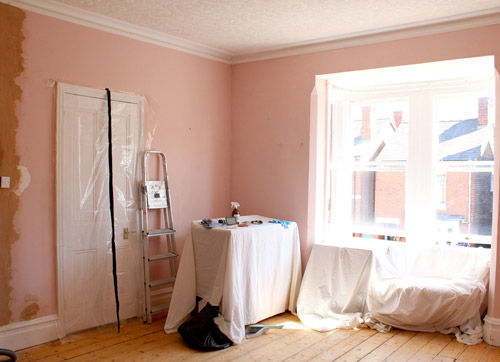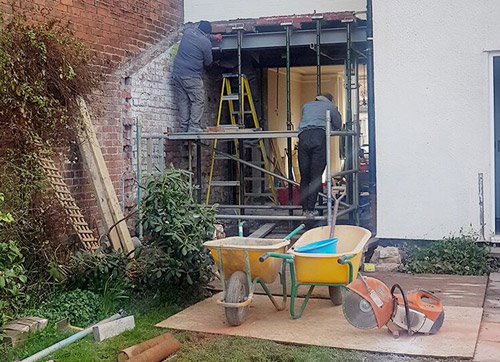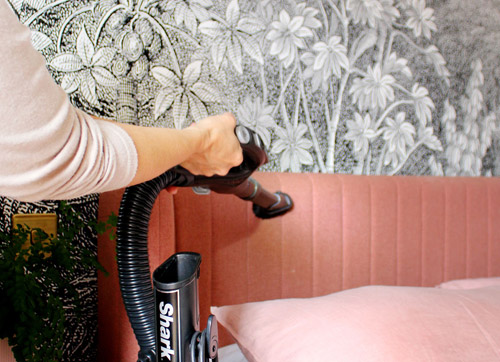Our site uses cookies to give you the best experience. or continue shopping if you're happy.
Accept & closeTop Tips: Minimise Mess In A Renovation
Take the stress out of your renovation as Kimberly takes us through useful tips to minimise mess throughout the process.
Planning a renovation is never a straight-forward process. With so many moving parts, from tradespeople to suppliers, architects and building regulations, you may easily overlook the one thing that will certainly have an impact on your everyday life: preparing the site and minimising the mess if you are going to be living in your home at the same time.
While having to live in your home during renovations will never be ideal, there are a few ways to make things a bit more bearable while any work is taking place. Much depends on the areas of your home that are being worked on, of course. A guest bedroom which is not used regularly will likely cause less impact in the rest of the home than a loft, kitchen or bathroom renovation and for these larger projects, there may be instances where moving out completely could be the best solution.
If you are going to be living in your home whilst work takes place, there’s probably no escape from the dust and mess that will likely seep into every other room of the house but there are ways to minimise the impact of your project to make living through it just a little easier.
Step 1
Communicate Before Work Begins
Before the first brick is removed, make sure you have a discussion with your tradespeople or contractor to understand the order in which work will proceed. A rough timeline will allow you to prepare the spaces that will be worked on in advance as well as any adjoining rooms that may be impacted. Will your tradespeople be using your bathroom or kitchen facilities? Will they need access to hallways or stairwells? Will they need to shut off essential services at times to complete the work?
Once you have an idea of how the work will proceed and how long certain rooms will either be out of action or where access is required, you’ll be better equipped for what’s to come and how much you’ll need to prepare in the rest of your home.
You’ll also want to manage your expectations in terms of the cleanliness of the site. While most contractors will sweep away debris or put away tools at the end of the day, there may be scuffing of floors or thick dust that will need to be taken care of once they have finished the job.
Step 2
Clear Your Room Completely Before Work Begins
Almost every renovation project will create some kind of dust or mess and so one of the easiest things you can do is completely clear out the rooms that are being worked on to minimise the impact on your possessions.
Where you can’t move out items, cover them completely with plastic sheeting and use masking tape to seal them against dirt, dust and damage.
Step 3
Cordon Off Renovation Areas If Possible
If you can, consider completely cordoning off the area being renovated by installing heavy tarps or sheeting and using masking tape to secure it along the walls, ceilings and floors in open plan areas to minimise the mess into other rooms. You can also purchase door covers that come with zippers to allow access whilst still keeping as much of the dust and mess contained as possible.
Step 4
Protect Floors in the Renovation and High-Traffic Areas
If your tradespeople will be using areas like hallways and stairwells to gain access to any renovation zones, consider installing some floor protection in any areas where there will be heavy footfall. Rolls of lightly adhesive plastic or drop cloths can go over hard flooring or carpeting to keep any damage, scuffs and dirt to a minimum in and out of your renovation area.
You might also want to consider placing large sheets of inexpensive plywood directly outside of your home to minimise any mud and dirt tracked into the house from outside.
Step 5
Open Windows Every Day to Allow Fresh Air In
Of course, no matter what you do, dust particles are going to enter just about every area of your home. Carried in the air and able to get into even the smallest gap, you can minimise it, but the likelihood is that you’ll still have it hanging around.
If you can, consider regularly leaving windows open to allow fresh air to circulate in your home.
Step 6
Tools to Keep on Top of The Mess
For everything you do to minimise the chaos of a renovation, regular cleaning is one of the best ways to keep the dust and dirt at bay.
A good quality vacuum cleaner will likely be put into service on an almost everyday basis. Carpets and rugs will trap dust and dirt so regularly going over floors will lift that embedded dust away. Be sure to clean or replace your filters regularly.
Make use of smaller vacuum attachments to get into corners or the brush attachment to go over soft furnishings, upholstery or curtains.
Step 7
A steam cleaner is a great way to keep harder floor surfaces clean without having to use any additional chemicals. Choose the correct setting for your floor type and use regularly to lift up ground in dirt and dust on tiles, laminate or wood flooring.
Step 8
Finally, an air purifier will regularly clean and filter the air in your home, helping to reduce the amount of dust before it lands on your surfaces. Consider placing them in both the rooms you are using during and as well as the renovation zone after your project is completed.












